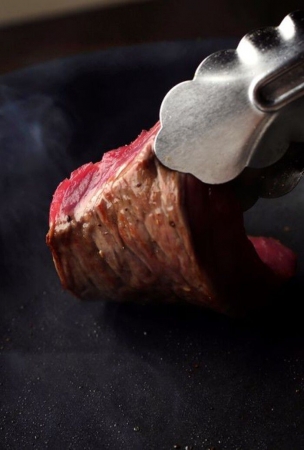Gohan Lab Steak Of Lean Beef: Sugar Turns Meat Brown, Enhancing Aroma, Flavor
 When cooking steak at home, lean meat is a recommended choice.
When cooking steak at home, lean meat is a recommended choice.
Parts labeled as "beef round" ("momo") or "rump" ("rampu") are lean meat fit for steak. While the round is simple and light, the rump covering the hip to the rump is richer and softer.
If lean meat is cooked in the same way as fatty meat, it will turn out hard and dry. The two seemingly conflicting keys when cooking are to turn the meat fragrant and brown, yet also moist.
Sugar helps the meat turn brown. Even a small amount will brown the meat when the latter touches the hot frying pan and will enhance the aroma and flavor.
The meat is pan-fried for a short time and the pan’s "residual heat" is used to heat the meat to the center after turning off the stove. If you cover the meat with aluminum foil, you can recreate the art of the chef who uses the oven in the final stage.
Salt is sprinkled in moderation at first, so you may season the meat as you like at the table. Soy sauce flavored with wasabi is a perfect choice, while whole-grained mustard is good, too.
Like last week, Naohito Yoshikawa, who heads the Research Institute of Salt and Sea Water Science, explains the differences in the abundant variety of salts.
"Although sea water, solar salt and rock salt are listed as raw materials, they are all derived from sea water," he says.
The difference in the salt’s purity when it is turned into a product is believed to affect how salty it tastes.
Salt with a high degree of purity is dry and powdery common salt ("shokuen") at 99.5 percent. Meanwhile, moist salt often sold as local specialties have a purity of around 95 percent. The remaining bittern component such as magnesium is believed to take the edge off the saltiness when licked.
Rock salt with a purity of about 99 percent is not found in Japan and is therefore imported. As it does not deteriorate, salt is not given a "best before date." Use it without worry.
BASIC COOKING METHOD
(Supervised by Kuniaki Arima in the cooking aspect and Midori Kasai in the cookery science aspect)
* Ingredients and cooking utensils (Serves one)
1 slice (about 80 grams) lean beef, 1/8 tsp sugar (cane sugar or brown-colored sugar [san’on-to] if available), 1/8 tsp salt, 1/2 tsp oil, paper towel, frying pan, tongs or spatula, aluminum foil
1. Take beef out of fridge and pat dry surface with paper towel if wet. Leave at room temperature for about 10 minutes. Sprinkle sugar, then salt on surface (PHOTO A). One side will suffice. Cut aluminum foil into size large enough to wrap meat.
2. To get the doneness of medium rare, place frying pan on lower medium heat and heat sufficiently before pouring in oil. The temperature is right if meat sizzles when it touches the pan. Place meat in the center of pan, while making sure that oil touches the side sprinkled with sugar and salt (PHOTO B). Oil will coat the entire side of meat.
3. If aroma rises, it is a sign that meat has browned. If meat is about 1.5 cm thick, turn sides after 40 to 50 seconds. After cooking the reverse side for 40 to 50 seconds, turn off heat and wrap meat with foil.
4. Place wrapped meat on pan that is still hot on the stove. Leave for 4 to 5 minutes occasionally turning sides so the residual heat will be transmitted to the center (PHOTO C). Open the foil and serve meat on plate. Pour juice in foil if preferred. If meat is thinly sliced at an angle, the fiber is cut, making it easier to eat.
***
Kuniaki Arima is the owner-chef of Passo a Passo, an Italian restaurant in Tokyo’s Fukagawa.
Midori Kasai is a professor at Ochanomizu University and chairperson of the Japan Society of Cookery Science.
ARRANGED VERSION
The meat will be subtly aromatic with enhanced umami if it is flavored with miso available at home. Use about 1 tsp miso for 80 grams of meat. Apply on one side instead of sugar and salt and leave for 5 to 10 minutes. The cooking procedure is the same, but the amount of oil is increased to 1 tsp, as miso burns easily. Boiled vegetables (wild asparagus ["asupara sobaju"] in photo) and fresh tomato may accompany the meat.
COOKERY SCIENCE
When meat is seared and gives off an appetizing aroma, the aminocarbonyl reaction (Maillard reaction) is taking place. It is a chemical reaction between amino acids of food and protein, and sugar and resolvents of fat. Heating enhances the reaction and creates aroma and turns cakes and rice crackers brown.



















